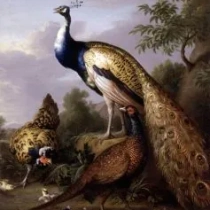Landscape In The Adirondacks
Frederic Edwin Church, a prominent figure in the Hudson River School, created "Landscape In The Adirondacks" in 1870. This particular piece depicts the vast and serene landscape of the Adirondack region in upstate New York. Church's meticulous attention to detail and use of light and color capture the essence of the untamed wilderness, evoking a sense of grandeur and tranquility.
The painting's composition draws the viewer's gaze into the distance, where the dramatic interplay of light and shadow accentuates the rugged terrain and majestic natural formations. Church's skillful portrayal of the atmospheric effects, such as the soft mist and luminous sky, adds a sense of ethereal beauty and timelessness to the scene.
Church's profound reverence for nature is evident in "Landscape In The Adirondacks," as he masterfully conveys the sublime power and delicate harmony of the natural world. The painting is a testament to Church's ability to convey the spiritual and emotional significance of the American landscape, inspiring contemplation and awe in the observer.
"Landscape In The Adirondacks" stands as a testament to Frederic Edwin Church's legacy as a visionary artist who sought to capture the awe-inspiring essence of the American wilderness. The painting continues to resonate with audiences, inviting them to immerse themselves in the timeless beauty of nature and reflect on the profound connection between humanity and the natural world.







No Comments Yet...